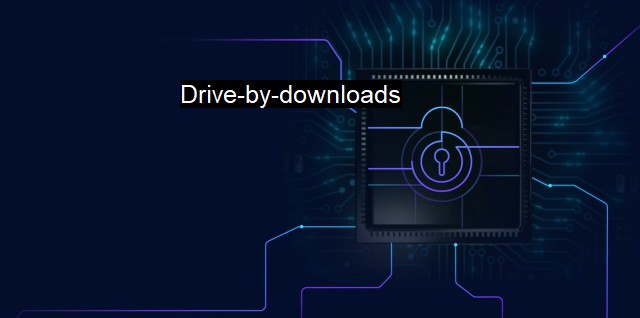What are Drive-by-downloads?
Drive-by-Downloads: The Dangerous Threat Cybersecurity Must Tackle Through New Antivirus Solutions and Advanced Protection Mechanisms
Drive-by-downloads is an insidious technique malicious actors use piggybacking onto seemingly innocuous downloads or even requiring no consent or knowledge anymore from the user before the potentially harmful software installs itself onto their system. This pernicious technological development has necessitated significant advancements in antivirus and other cybersecurity software to combat the growing variety of threats businesses, governments, and private individuals now face on a regular basis.Images, links, and even hidden codes infused in the webpage's basic structure can now harbor cryptographic sequences set to auto-run. In doing so, payloads containing malicious software download onto a device whenever users visit or interact with the compromised webpage, most of the time completely unbeknown to these individuals. These scripts run in the background, silently planting corrupt programs into the operating system under the pretense of wholesome activity.
This installation practice differs from more conventional methods in that traditional downloads usually get stored in a separate folder before users double-click the file to run and initiate it, giving multiple protections in benefiting from separated stages. Drive-by-downloads on the other hand commence installation immediately, and in some advanced techniques install the malicious software merely by loading the compromised website, offering users no chance to cancel the from-to-be action.
Drive-by-downloads pose a considerable threat to our digital world as our reliance on internet connectivity intensifies. Exploiting weaknesses in everything from internet browsers to the very Operating System provides ample opportunities for cybercriminals to infiltrate devices. This issue shows no sign of retreating as people continue to make mistakes like visiting unsecured or suspicious sites.
Taking the technological race between hackers and whitehat cybersecurity experts into consideration, new-gen antivirus software is evolving, integrating enhancements capable of detecting unauthorized downloads by undertaking continual scans of system processes, alerting users to any abnormalities and providing them the option to terminate any suspicious download process.
Advanced heuristic engines within modern antivirus software are finely tuned to detect potentially shady scripts through ‘intelligent’ recognition mechanisms, thus preemptively combating the risk of drive-by-downloads. Operating on the principle of patterns, they are not limited by a strict library of known viruses, but can also anticipate new strains of viruses based on detected patterns of harmful regular behavior.
Cloud-Computing resources can further empower these antivirus software measures, allowing globally shared intelligence on newly detected or evolving threats. By compiling worldwide data onto one centralized database, updated in real-time, antivirus software can deliver immediate push updates before even a single download takes place.
Many cybersecurity practices emphasize user caution and education as antidotes to these threats. Staying away from suspicious sites, as well as sites without "HTTPS" protocols embedded, and not downloading files from unfamiliar sources are common advice. Yet, considering that modern threats require less direct interaction from users to inflict harm, the role of education evidently has its limitations. This is where antivirus software's relentless vigilance and ability to quarantine potential threats before any lasting harm can take precedence in the armor of digital protection.
"drive-by-downloads" presents a substantial and growing danger in our digital world today. Users may never be fully alert to stop them, making the importance of antivirus software protection multiplicative in regards to the stakes. The contests between cybersecurity professionals and hackers will never end, but with advanced antivirus solutions and growing awareness, our digital security systems are increasingly capable of detecting and neutralizing these lurking threats.

Drive-by-downloads FAQs
What is a drive-by-download?
A drive-by-download is a type of cyber attack where malware is automatically downloaded and installed on a user's computer without the user's knowledge or consent while browsing the internet.How does a drive-by-download happen?
Drive-by-downloads can happen if a user visits a compromised website, clicks on a malicious link, or interacts with a pop-up window that contains hidden code. These actions can trigger the automatic download and installation of malware on the user's computer.How can I protect myself from drive-by-downloads?
You can protect yourself from drive-by-downloads by installing and regularly updating antivirus software, using a reputable browser with pop-up blockers enabled, and avoiding suspicious websites and links. It is also essential to keep your operating system and software up-to-date with security patches to prevent vulnerabilities.What should I do if I suspect a drive-by-download on my computer?
If you suspect a drive-by-download on your computer, immediately run a full system scan using your antivirus software. If the scan detects malware, follow the software's recommended action to remove it. You should also change any passwords you may have used while the malware was on your computer as a precaution.| | A | | | B | | | C | | | D | | | E | | | F | | | G | | | H | | | I | | | J | | | K | | | L | | | M | |
| | N | | | O | | | P | | | Q | | | R | | | S | | | T | | | U | | | V | | | W | | | X | | | Y | | | Z | |
| | 1 | | | 2 | | | 3 | | | 4 | | | 7 | | | 8 | | |||||||